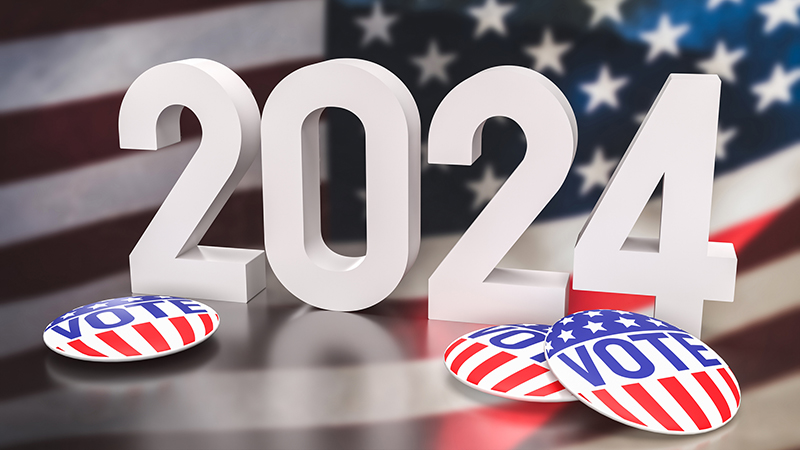With the UK results in, the next biggest election is less than four months away, and polls continue to point to a close contest between incumbent president Joe Biden and former leader Donald Trump.
Despite the electoral uncertainty, US economic growth remains strong with the S&5 500 closing the first half of the year up 14.5%.
However, many commentators have expressed nervousness about US equity valuations, particularly following the strong recent run for numerous AI-aligned tech names. Five investment professionals give their outlook for the US economy in the run up to November 5th.
Jill Jortner, investment analyst at T. Rowe Price
The 2024 US presidential election campaign has been noteworthy for the lack of big‑ticket issues or policies from either leading candidate.
Healthcare, for example, historically has been one of the hottest of all political potatoes during election years – given the scope for impactful change – but it has featured much less prominently in either candidate’s campaigning in this election cycle.
This low-key focus has been less disruptive for the healthcare sector than in recent election year campaigns, which has been duly reflected in markets, with the sector posting positive returns in 2024 to date, albeit trailing the broader equity market’s rally.
Whoever is ultimately elected in November, we would expect healthcare spending to continue rising. Even though both candidates have voiced a desire to bring down medical inflation, and specifically to rein in high drug prices, total spending will continue to be driven higher by patient demand, an ageing population, and the cost of medical services and innovation.
Should president Biden win, we expect total healthcare expenditure to increase, with public spending outpacing private. In the event of a Trump victory, we anticipate increased private health expenditure, at the expense of public programmes. Pharmaceutical companies could also be better off, should a new Trump administration revoke Medicare’s power to negotiate drug prices directly.
Rebekah McMillan, portfolio manager at Neuberger Berman
We continue to see slowing growth in the US. While normalising inflation and monetary policy should be supportive, lower macro tails have made way for higher political tails as we approach the election.
Historically in closely contested US election years, we see a pattern whereby risk premium builds up in the fourth quarter before being released in November post-result as uncertainty is removed, irrelevant of the winning candidate, party or policies.
However, recent elections in India, Mexico, Argentina reminds us surprises can disrupt markets, making us more wary of volatility coming in throughout the fourth quarter.
The policy differences between candidates are clear, be it fiscal, tax or regulatory matters. But much will hinge on the composition of government in supporting or impeding the ability of the president elect to enact policy change. Large shifts in fiscal policy are more likely under unified governments, potentially resulting in larger asset price moves.
Markets may also pay attention to sustainability of public debt as it relates to any proposal for meaningful fiscal expansion. Additionally, the candidates’ approach to tariffs (particularly on China) and climate policies differ, presenting opportunities for more tactical equity investors. Foreign and domestic security priorities also diverge between the two, but defence spending should remain robust in both scenarios.
Paul Middleton, manager of the Mirabaud Sustainable Global Focus fund
There are few certainties when it comes to the US election in November – save for the fact that whichever way it goes, the outcome is likely to be contested, even more so if Biden wins. Because of this, the initial reaction to the result may be fairly muted.
A Biden victory would clearly mean little change in the markets, but volatility around certain sectors like managed care – which tend to underperform in election years – would be removed, enabling these stocks to start performing better.
A Trump victory would cause more disruption in markets, but it would be much less of a shock than in 2016 as he is the current favourite and we know more about his policies now.
The market’s overall tone would likely be constructive. Trump will be seen to be more favourably biased towards large M&A, and in general more business friendly. He has been very vocal about his dislike of some renewables sectors such as offshore wind and EVs, and these sectors are likely to be volatile. We would also be cautious on companies with supply chain dependency on China.
Raphael Olszyna-Marzys, economist at J. Safra Sarasin Sustainable Asset Management
The upcoming US elections will significantly impact the global economy and financial markets. Both candidates’ programmes share significant similarities and differences.
What is clear is that both will persist with protectionist policies to bolster the industrial base and reduce reliance on China. However, such protectionism is likely to hinder long-term economic growth.
The budget deficit will remain substantial for years as spending continues to rise due to an ageing population, while tax revenues remain insufficient. Persistent large deficits could partially crowd out private investment and push up the long-run equilibrium interest rate. The debt-to-GDP ratio will almost certainly climb under either Trump or Biden.
Overall, we believe Trump’s policies are likely to result in slower economic growth, higher inflation, increased bond yields, and a weaker dollar in the medium to long term. In the short term, a looser fiscal policy stance could provide a temporary boost to the economy, potentially lifting equity prices.
And any additional tariffs under Trump might initially strengthen the dollar, though this effect would likely diminish over time.
Tom O’Shaughnessy, head of North America at Amber Infrastructure
Renewable energy demand in the US tends to be driven by state initiatives rather than federal ones and is often largely apolitical. However, the Inflation Reduction Act (IRA) demonstrates the impact federal policy can have on the supply of renewable energy.
The act, which has been central to President Biden’s economic agenda, has been transformational for energy development projects by providing more upfront capital for construction, allowing developers to effectively monetise the additional tax credits, and therefore reduce project costs.
Despite this, the IRA remains highly politicised, with former President Trump and some Republicans criticising the act and pledging to repeal parts of it should the party win.
So the future of federal support of renewables remains uncertain. We think any changes in federal policy that delay or inhibit new development are likely to have the knock-on effect of increasing Power Purchase Agreement (PPA) prices, which would be broadly positive for operational assets. But any policies that accelerate or subsidise new project development could result in cheaper renewable energy.
The role of state and federal governments and their policies will play a vital role in shaping the US renewable energy landscape regardless of who wins in November.







